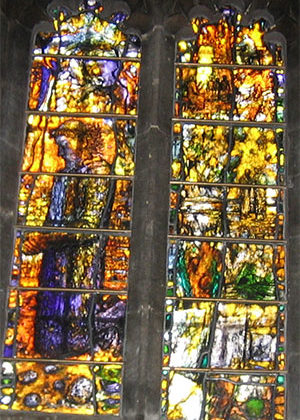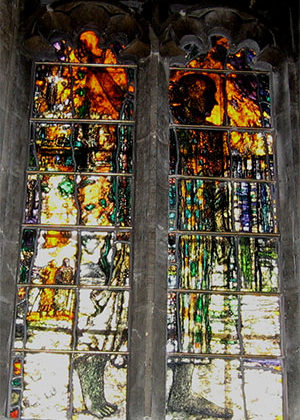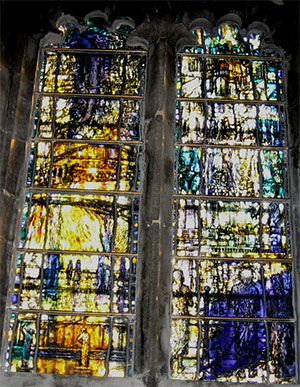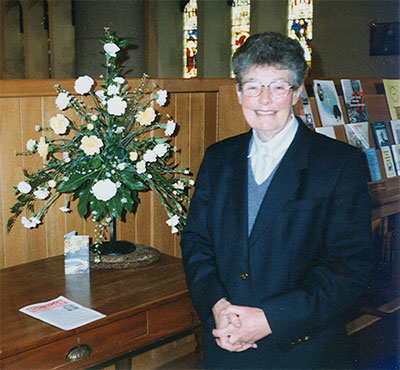The Vision of the Designer – Thomas Denny Belchalwell Dorset

Introduction

The Bede Chapel is an intimate space with three windows enveloping the altar. Stained glass in the windows contributes profoundly to the character and atmosphere of the chapel. Unity of colour is important here and I would hope that the windows can be enjoyed as a unified whole, but also explored individually.
The colour, golden with areas of near whites and passages of more intense cooler colours, is intended to work in the particular situation of the Bede Chapel, where much of the daylight is partially obscured by buildings: golden windows will appear to draw light into the Chapel.
The leadlines are unassertive and supportive of the rhythms expressed in the colour and light. The pieces of glass have many colour changes arrived at by way of acid etching, plating and silver staining.
The theme for the new stained glass in the Bede Chapel is prayer, contemplative and active, as expressed in the lives of Bede and Benedict Biscop and their relationship with the City of Sunderland.
“Seek the welfare of the City…….and pray to the Lord on it’s behalf, for in it’s welfare will you find your welfare” (Jeremiah 29 v 7)
The three windows are designed as a whole, with interconnecting strands of storytelling and colour, ideas and possibilities. Each one also has its own particularity.
South Window

In the South Window Bede kneels in prayer at the shore of the sea. Bede describes in his writings, Cuthbert standing all night in prayer as the sea rises and ebbs about him and Bede is depicted here as drawing inspiration from Cuthbert in the same way as we can draw inspiration from Bede; history and it’s inhabitants are embedded in our own lives.
The character of this shore is that of Roker and Seaburn, with its mysterious and beautiful honeycombed rocks. Above Bede, an owl moves up towards the moon, conveying a sense of night and its quietude. Bede’s landscape, bounded by the rivers Wear and Tyne, is suggested, map like, behind him.
The right hand light contains memories, events, activities of his life – writing, teaching, comforting, conversing on a cliff walk.
“Pages” emerge as one looks down the window, themselves full of fragmentary letters and miniature scenes: an angel greets a newly made church on a knoll; a rider begins a journey; a figure walks on an island. The border is formed by crosses, varying in shape and embodying the idea of individuals in a Christian community.
North Window

The North Window is about Biscop, who walks and gestures like a giant sower, scattering his achievements around him, his movements and activity balancing Bede’s stillness and contemplativeness. Biscop occupies an empty, stony place, tower like structures behind him – a potential city.
The left hand light contains figures who represent aspects of the extraordinary fruitfulness of Biscop’s life. At the top of the window a man sings in a hilly landscape; two stonemasons work on the making of a church; a glassblower forms a globe of colour; two figures (a young Biscop with an ancient Wilfred) walk towards Rome.
In the left hand border, minute images from the Book of Revelations can be found – Biscop brought paintings of this among other themes into his church.
Central Window

The Central Window has areas of intense violet that seem to emanate from the outer supporting windows and a structure of nebulous columns of colour.
This window is about the city, with its layers of time, humanity, life, structures, memories, preoccupations.
In the right hand light a group of “pilgrims” stands gazing across the river. Fragments of cityscape occupy the panels of the window above them: pavements and rain framed by shards of Sunderland pottery; walking figures in front of a distant glimpse of cranes and sea; terraces climbing up and down hills; a church and skyline.
In the left hand light men work on a vast girder like structure;
Sunderland bridges can be seen in their various embodiments with figures encountering one another as they walk around.
We then see a bird’s eye “map” of the city and the mouth of the Wear.
There are thus many narratives and details to explore in the windows and also much room for the imagination of the viewer. It is hoped that the glass will feel full of potential and that it will reward those who return over the weeks and years.
Each light contains some Sunderland made glass. Mostly, however, the glass came from English Antique Glass of Birmingham, which means that it was blown by Sunderland men who moved there when Sunderland glassmaking at the Hartley Woods foundry ceased.
Theodosia Ann Ferguson

The installation of these new windows was made possible through a bequest made by the late Theodosia Ann Ferguson (Theo), who died on 16th July 2002. It was decided that part of this bequest be used to commission new stained glass windows in the Bede Chapel.
Theo was born in London on 7th October 1925 but lived in various parts of the UK. After graduating in English from London University, she settled in Sunderland in 1948, teaching English at Seaham Grammar School. Theo was a prominent Guide leader becoming Deputy Chief Commissioner in 1982. She was also an active and valuable member of Christ Church. When this closed in 1998 she moved to Sunderland Minster and became Church Warden in 2000 until her death.
During her time as a member of the Minster congregation, Theo worshipped weekly in the Bede Chapel. She fully supported the widening of the Minster’s ministry towards the City of Sunderland and I am sure would have been thrilled with Thomas Denny’s wonderful windows depicting St Bede, Benedict Biscop and the various scenes past, present and future of the life of Sunderland.